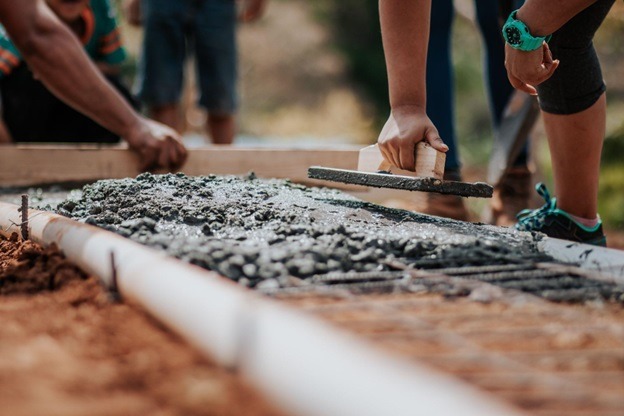Stamped concrete may be used to pave a patio, sidewalk, driveway, or other surface. This newer generation of imitations is almost indistinguishable from the real thing. In addition, stamped concrete has all the advantages of concrete, including the great durability that these other materials lack.
Stamped concrete resembles brick, stone, or tile by adding color, pattern, and/or texture. Some individuals choose to utilize a stamped concrete Tampa Pro instead of the materials it is meant to imitate because of its lower cost. In addition, the number of designs that can be printed in stamped concrete is impressive, and it means there is something for virtually everyone when it comes to having it installed at your home. There is no limit to the imagination that can be used with concrete products.
Many Stamped Concrete Designs
When stamping a design onto wet cement, rubber stamps and texturizing mats are used to make the impression. It may also be applied over an existing concrete slab, provided the latter is in good enough condition to support the process. Often, molds of the actual material are used to create these stamps so that they have the correct texture. They are capable of giving concrete the appearance of brick, cobblestone, slate, and even wood boards. On a concrete floor, you may even put big medallions and other unique embellishments.
As an added bonus, the stamps may be used for a wide variety of purposes beyond flooring thanks to their versatility and ability to be placed in both the horizontal and vertical planes. You may, for instance, cover the pavement around your outdoor fireplace with stone. You may also fake the appearance of a brick wall by using concrete.
In addition, there is no reason why you can’t install stamped concrete on the interior of your house. Moreover, it may serve as a functional and aesthetically pleasing coating. Concrete basement floors may be stamped to seem like wood, a popular choice. Very long-lasting, stamped concrete (https://en.wikipedia.org/wiki/Stamped_con) may be made to look like tile for the kitchen. Nonetheless, it may be chilly and rough on the feet, thus soft area rugs are advised.
Methods for Making Stamped Concrete
Stamped concrete may be made with little effort. The following are typical parts of the process:
- The cement should be poured at least four inches deep.
- Include the accent hue. Cement may be colored before or after it is poured. Integral coloring is one approach, while surface coloring is the other. The method of broadcast coloring entails distributing color uniformly over the surface of wet cement.
- Use the dye-removing solvent. Stamped concrete gains depth from the color release, which also has a nonsticking action that facilitates the removal of the texturizing mats without damaging the concrete.
- Distribute the texturizing mats. It is necessary to apply the mats although the concrete is still wet and then move them so that they cover the whole area. If the design has uninterrupted lines, you’ll need to take extra care while rearranging the mats to keep them in perfect alignment.
- Hold off on building until the cement has dried for a full day.
- Remove the lubricant by blasting it with water.
- Seal it with a clear coating, then wait for it to cure. After 48 hours, the concrete will be dry enough for walking, and in a week, it will be dry enough for driving. Around a month is needed for a complete recovery.
- Do-it-yourself methods should be avoided. Stamped concrete installation is a fine craft. It also requires specialized equipment and a competent team. Choose a reliable concrete company that has prior expertise laying stamped concrete to save unnecessary hassle.
Stamped Concrete: The Benefits and Drawbacks
Many options in flooring materials are available to you. So, should you use stamped concrete for your task? It is quite versatile and may last for a very long time. Furthermore, if it is textured or otherwise enhanced with a non-skid additive, it may serve as a secure, slip-resistant floor. Click here to read more about slip resistant flooring. In the same way that brick and stone may raise the value of your property, stamped concrete can do the same thing for less money.
Stamped concrete is beautiful, but it usually requires professional help, which is a drawback. It is also advised to reseal concrete between once every two and five years in order to preserve its finest appearance. If the concrete fractures, it may be hard to repair and match the stamped design.
Pros
A wide variety of personalization choices are available.
Disadvantages
It’s not easy to fix
The inability to do-it-yourself
The Advantages of Stamped Concrete over Competing Building Materials
Other common building materials, such as bricks and stones, may also increase your home’s beauty and resale value in the same ways that stamped concrete does. In addition to their usefulness in leveling out uneven surfaces, the many individual pieces that make up their surface make them a versatile building material. Pouring concrete on an unlevel surface may be challenging. Although nothing should grow through concrete, weeds can sprout between pavers.
In the end, perception is everything. Whether it’s bricks, stones, tiles, or wood, stamped concrete will always seem like concrete. And that’s a major turnoff for some customers. Stamped concrete, however, may be the answer if you’re searching for a low-maintenance, long-lasting substitute for the genuine thing.


